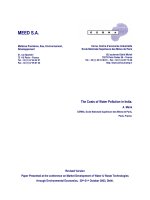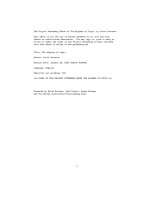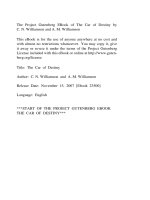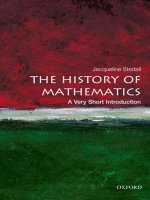The philosophy of mathematics, by Auguste Comte pot
Bạn đang xem bản rút gọn của tài liệu. Xem và tải ngay bản đầy đủ của tài liệu tại đây (1.4 MB, 635 trang )

Project Gutenberg's The philosophy of
mathematics, by Auguste Comte
This eBook is for the use of anyone
anywhere at no cost and with
almost no restrictions whatsoever. You
may copy it, give it away or
re-use it under the terms of the Project
Gutenberg License included
with this eBook or online at
www.gutenberg.org/license
Title: The philosophy of mathematics
Author: Auguste Comte
Translator: W. M. Gillespie
Release Date: May 15, 2012 [EBook #39702]
Language: English
*** START OF THIS PROJECT GUTENBERG EBOOK
THE PHILOSOPHY OF MATHEMATICS ***
Produced by Anna Hall, Albert László and
the Online
Distributed Proofreading Team at
(This
file was produced from images generously
made available
by The Internet Archive)
THE
PHILOSOPHY
OF
MATHEMATICS.
THE PHILOSOPHY OF
MATHEMATICS;
TRANSLATED FROM THE
COURS DE PHILOSOPHIE POSITIVE
OF
AUGUSTE COMTE,
BY
W. M. GILLESPIE,
PROFESSOR OF CIVIL ENGINEERING & ADJ.
PROF. OF MATHEMATICS
IN UNION COLLEGE.
NEW YORK:
HARPER & BROTHERS, PUBLISHERS,
82 CLIFF STREET
1851.
Entered, according to Act of Congress, in
the year one thousand
eight hundred and fifty-one, by
Harper & Brothers.
in the Clerk's Office of the District Court
of the Southern District
of New York.
PREFACE.
The pleasure and profit which the
translator has received from the great
work here presented, have induced him to
lay it before his fellow-teachers and
students of Mathematics in a more
accessible form than that in which it has
hitherto appeared. The want of a
comprehensive map of the wide region of
mathematical science—a bird's-eye view
of its leading features, and of the true
bearings and relations of all its parts—is
felt by every thoughtful student. He is like
the visitor to a great city, who gets no just
idea of its extent and situation till he has
seen it from some commanding eminence.
To have a panoramic view of the whole
district—presenting at one glance all the
parts in due co-ordination, and the darkest
nooks clearly shown—is invaluable to
either traveller or student. It is this which
has been most perfectly accomplished for
mathematical science by the author whose
work is here presented.
Clearness and depth, comprehensiveness
and precision, have never, perhaps, been
so remarkably united as in Auguste Comte.
He views his subject from an elevation
which gives to each part of the complex
whole its true position and value, while
his telescopic glance loses none of the
needful details, and not only itself pierces
to the heart of the matter, but converts its
opaqueness into such transparent crystal,
that other eyes are enabled to see as
deeply into it as his own.
Any mathematician who peruses this
volume will need no other justification of
the high opinion here expressed; but others
may appreciate the following
endorsements of well-known authorities.
Mill, in his "Logic," calls the work of M.
Comte "by far the greatest yet produced on
the Philosophy of the sciences;" and adds,
"of this admirable work, one of the most
admirable portions is that in which he may
truly be said to have created the
Philosophy of the higher Mathematics:"
Morell, in his "Speculative Philosophy of
Europe," says, "The classification given
of the sciences at large, and their regular
order of development, is unquestionably a
master-piece of scientific thinking, as
simple as it is comprehensive;" and
Lewes, in his "Biographical History of
Philosophy," names Comte "the Bacon of
the nineteenth century," and says, "I
unhesitatingly record my conviction that
this is the greatest work of our age."
The complete work of M. Comte—his
"Cours de Philosophie Positive"—fills
six large octavo volumes, of six or seven
hundred pages each, two thirds of the first
volume comprising the purely
mathematical portion. The great bulk of
the "Course" is the probable cause of the
fewness of those to whom even this
section of it is known. Its presentation in
its present form is therefore felt by the
translator to be a most useful contribution
to mathematical progress in this country.
The comprehensiveness of the style of the
author—grasping all possible forms of an
idea in one Briarean sentence, armed at
all points against leaving any opening for
mistake or forgetfulness—occasionally
verges upon cumbersomeness and
formality. The translator has, therefore,
sometimes taken the liberty of breaking up
or condensing a long sentence, and
omitting a few passages not absolutely
necessary, or referring to the peculiar
"Positive philosophy" of the author; but he
has generally aimed at a conscientious
fidelity to the original. It has often been
difficult to retain its fine shades and
subtile distinctions of meaning, and, at the
same time, replace the peculiarly
appropriate French idioms by
corresponding English ones. The attempt,
however, has always been made, though,
when the best course has been at all
doubtful, the language of the original has
been followed as closely as possible, and,
when necessary, smoothness and grace
have been unhesitatingly sacrificed to the
higher attributes of clearness and
precision.
Some forms of expression may strike the
reader as unusual, but they have been
retained because they were characteristic,
not of the mere language of the original,
but of its spirit. When a great thinker has
clothed his conceptions in phrases which
are singular even in his own tongue, he
who professes to translate him is bound
faithfully to preserve such forms of
speech, as far as is practicable; and this
has been here done with respect to such
peculiarities of expression as belong to
the author, not as a foreigner, but as an
individual—not because he writes in
French, but because he is Auguste Comte.
The young student of Mathematics should
not attempt to read the whole of this
volume at once, but should peruse each
portion of it in connexion with the
temporary subject of his special study: the
first chapter of the first book, for example,
while he is studying Algebra; the first
chapter of the second book, when he has
made some progress in Geometry; and so
with the rest. Passages which are obscure
at the first reading will brighten up at the
second; and as his own studies cover a
larger portion of the field of Mathematics,
he will see more and more clearly their
relations to one another, and to those
which he is next to take up. For this end he
is urgently recommended to obtain a
perfect familiarity with the "Analytical
Table of Contents," which maps out the
whole subject, the grand divisions of
which are also indicated in the Tabular
View facing the title-page. Corresponding
heads will be found in the body of the
work, the principal divisions being in
small capitals, and the subdivisions in
Italics. For these details the translator
alone is responsible.
ANALYTICAL TABLE OF
CONTENTS.
INTRODUCTION.
Page
GENERAL
CONSIDERATIONS ON
MATHEMATICAL
SCIENCE 17
The Object of Mathematics
18
Measuring Magnitudes
18
Difficulties 19
General Method
20
Illustrations 21
1. Falling
Bodies 21
2.
Inaccessible
Distances
23
3.
Astronomical
Facts 24
True Definition of
Mathematics 25
A Science, not an Art
25
Its Two Fundamental
Divisions 26
Their different Objects
27
Their different Natures
29
Concrete Mathematics
31
Geometry and
Mechanics 32
Abstract Mathematics
33
The Calculus, or
Analysis 33
Extent of Its Field 35
Its Universality 36
Its Limitations 37
BOOK I.
ANALYSIS.
CHAPTER I.
Page
GENERAL VIEW OF
MATHEMATICAL
ANALYSIS 45
The True Idea of an
Equation 46
Division of Functions
into Abstract and
Concrete 47
Enumeration of
Abstract Functions 50
Divisions of the Calculus
53
The Calculus of
Values, or Arithmetic
57
Its Extent 57
Its true Nature 59
The Calculus of
Functions 61
Two Modes of
obtaining Equations
61
1. By the Relations
between the given
Quantities 61
2. By the Relations
between auxiliary
Quantities 64
Corresponding
Divisions of the
Calculus of Functions
67
CHAPTER II.
ORDINARY ANALYSIS;
OR, ALGEBRA. 69
Its Object 69
Classification of
Equations 70
Algebraic Equations 71
Their Classification
71
Algebraic Resolution of
Equations 72
Its Limits 72
General Solution 72
What we know in
Algebra 74
Numerical Resolution of
Equations 75
Its limited Usefulness
76
Different Divisions of the
two Systems 78
The Theory of Equations
79
The Method of Indeterminate
Coefficients 80
Imaginary Quantities 81
Negative Quantities 81
The Principle of
Homogeneity 84
CHAPTER III.
TRANSCENDENTAL
ANALYSIS: its different
conceptions 88
Preliminary Remarks
88
Its early History 89
Method of Leibnitz 91
Infinitely small
Elements 91
Examples:
1. Tangents 93
2. Rectification of
an Arc 94
3. Quadrature of a
Curve 95
4. Velocity in
variable Motion
95
5. Distribution of
Heat 96
Generality of the
Formulas 97
Demonstration of the
Method 98
Illustration by
Tangents 102
Method of Newton 103
Method of Limits 103
Examples:
1. Tangents 104
2. Rectifications
105
Fluxions and Fluents
106
Method of Lagrange 108
Derived Functions
108
An extension of
ordinary Analysis
108
Example: Tangents
109
Fundamental Identity
of the three Methods
110
Their comparative
Value 113
That of Leibnitz 113
That of Newton 115
That of Lagrange 117
CHAPTER IV.
THE DIFFERENTIAL AND
INTEGRAL CALCULUS
120
Its two fundamental
Divisions 120
Their Relations to each
Other 121
1. Use of the
Differential Calculus as
preparatory to that of
the Integral 123
2. Employment of the
Differential Calculus
alone 125
3. Employment of the
Integral Calculus alone
125
Three Classes of
Questions hence
resulting 126
The Differential Calculus
127
Two Cases: Explicit
and Implicit Functions
127
Two sub-Cases: a
single Variable or
several 129
Two other Cases:
Functions separate
or combined 130
Reduction of all to the
Differentiation of the
ten elementary
Functions 131
Transformation of
derived Functions for
new Variables 132









